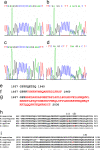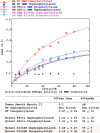Unregulated smooth-muscle myosin in human intestinal neoplasia
- PMID: 18391202
- PMCID: PMC2291082
- DOI: 10.1073/pnas.0801213105
Unregulated smooth-muscle myosin in human intestinal neoplasia
Abstract
A recent study described a recessive ATPase activating germ-line mutation in smooth-muscle myosin (smmhc/myh11) underlying the zebrafish meltdown (mlt) phenotype. The mlt zebrafish develops intestinal abnormalities reminiscent of human Peutz-Jeghers syndrome (PJS) and juvenile polyposis (JP). To examine the role of MYH11 in human intestinal neoplasia, we searched for MYH11 mutations in patients with colorectal cancer (CRC), PJS and JP. We found somatic protein-elongating frameshift mutations in 55% of CRCs displaying microsatellite instability and in the germ-line of one individual with PJS. Additionally, two somatic missense mutations were found in one microsatellite stable CRC. These two missense mutations, R501L and K1044N, and the frameshift mutations were functionally evaluated. All mutations resulted in unregulated molecules displaying constitutive motor activity, similar to the mutant myosin underlying mlt. Thus, MYH11 mutations appear to contribute also to human intestinal neoplasia. Unregulated MYH11 may affect the cellular energy balance or disturb cell lineage decisions in tumor progenitor cells. These data challenge our view on MYH11 as a passive differentiation marker functioning in muscle contraction and add to our understanding of intestinal neoplasia.
Conflict of interest statement
The authors declare no conflict of interest.
Figures


Similar articles
-
Somatic mutation analysis of MYH11 in breast and prostate cancer.BMC Cancer. 2008 Sep 17;8:263. doi: 10.1186/1471-2407-8-263. BMC Cancer. 2008. PMID: 18796164 Free PMC article.
-
Graded effects of unregulated smooth muscle myosin on intestinal architecture, intestinal motility and vascular function in zebrafish.Dis Model Mech. 2016 May 1;9(5):529-40. doi: 10.1242/dmm.023309. Epub 2016 Feb 18. Dis Model Mech. 2016. PMID: 26893369 Free PMC article.
-
Smooth-muscle myosin mutations in hereditary non-polyposis colorectal cancer syndrome.Br J Cancer. 2008 Nov 18;99(10):1726-8. doi: 10.1038/sj.bjc.6604737. Epub 2008 Oct 21. Br J Cancer. 2008. PMID: 18941465 Free PMC article.
-
[Hereditary colorectal cancer].Korean J Gastroenterol. 2005 Feb;45(2):78-87. Korean J Gastroenterol. 2005. PMID: 15725711 Review. Korean.
-
Pathology and genetics of hereditary colorectal cancer.Pathology. 2018 Jan;50(1):49-59. doi: 10.1016/j.pathol.2017.09.004. Epub 2017 Nov 21. Pathology. 2018. PMID: 29169633 Review.
Cited by
-
Effects of increase in fish oil intake on intestinal eicosanoids and inflammation in a mouse model of colitis.Lipids Health Dis. 2013 May 31;12:81. doi: 10.1186/1476-511X-12-81. Lipids Health Dis. 2013. PMID: 23725086 Free PMC article.
-
Somatic mutation analysis of MYH11 in breast and prostate cancer.BMC Cancer. 2008 Sep 17;8:263. doi: 10.1186/1471-2407-8-263. BMC Cancer. 2008. PMID: 18796164 Free PMC article.
-
Safety and efficacy of an enteroscopy-based approach in reducing the polyp burden in patients with Peutz-Jeghers syndrome: experience from a tertiary referral center.Ther Adv Gastrointest Endosc. 2020 May 14;13:2631774520919369. doi: 10.1177/2631774520919369. eCollection 2020 Jan-Dec. Ther Adv Gastrointest Endosc. 2020. PMID: 32705081 Free PMC article.
-
Identification of hub genes and pathways in bladder cancer using bioinformatics analysis.Am J Clin Exp Urol. 2022 Feb 15;10(1):13-24. eCollection 2022. Am J Clin Exp Urol. 2022. PMID: 35291419 Free PMC article.
-
Human Tonic and Phasic Smooth Muscle Myosin Isoforms Are Unresponsive to the Loop 1 Insert.ISRN Struct Biol. 2013 Jan 1;2013:634341. doi: 10.1155/2013/634341. ISRN Struct Biol. 2013. PMID: 24587982 Free PMC article.
References
-
- Laing NG, Nowak KJ. When contractile proteins go bad: The sarcomere and skeletal muscle disease. BioEssays. 2005;27:809–822. - PubMed
-
- Liu P, et al. Fusion between transcription factor CBF beta/PEBP2 beta and a myosin heavy chain in acute myeloid leukemia. Science. 1993;261:1041–1044. - PubMed
-
- Boland CR, et al. National Cancer Institute workshop on microsatellite instability for cancer detection and familial predisposition: development of international criteria for the determination of microsatellite instability in colorectal cancer. Cancer Res. 1998;58:5248–5257. - PubMed
-
- Hienonen T, et al. Mutations in two short noncoding mononucleotide repeats in most microsatellite-unstable colorectal cancers. Cancer Res. 2005;65:4607–4613. - PubMed
Publication types
MeSH terms
Substances
Associated data
- Actions
LinkOut - more resources
Full Text Sources
Other Literature Sources
Molecular Biology Databases
Miscellaneous

